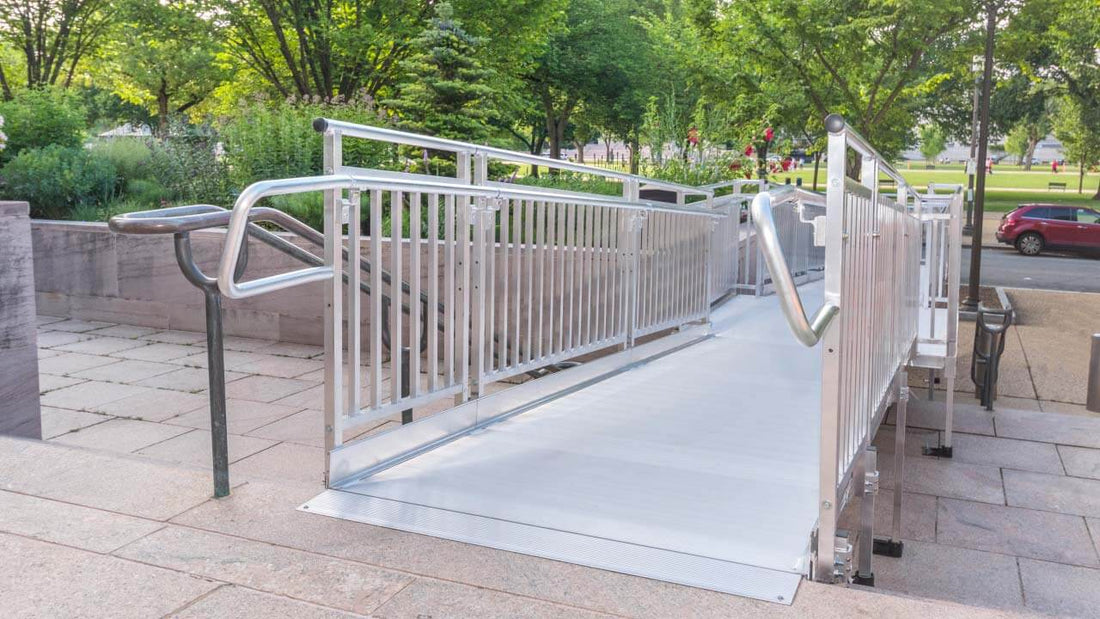When it comes to providing accessibility for individuals who utilize a mobility device such as a wheelchair or scooter, some commercial businesses put forth a great deal of effort, and it shows by the structures used. But others simply do enough just to meet their legal obligation. It's important now, more than ever, to ensure that your commercial business is up to standard when it comes to wheelchair access. If the events of the past year have shown us anything, it's that things can quickly change and cause businesses to scramble to meet the needs of the public. Failing to create handicap access is not only a requirement under the law, but it can also create enormous obstacles for those living with disabilities every day to receive essential services.
We believe the way to operate a commercial business is to go the extra mile to accommodate everyone. The impact that it has on the life of a person with disabilities can have lasting effects. But with so many different types of wheelchair ramps, it may be difficult to decipher which one is best for your particular building. Are you aware of the options available? Has your commercial building changed in recent years, and better accommodations are now warranted? Now is the time to get it right and ensure that the building is fully prepared with the appropriate wheelchair access. Keep reading to discover which wheelchair ramp would best suit your commercial business and how EZ-ACCESS can help!
How do commercial businesses impact disabled individuals with wheelchair ramps?
Wheelchair ramps should be specifically designed to provide ease of access for wheelchairs, scooters, and for all who face mobility challenges. The overall intent should be to allow those with limited mobility to bypass any obstacles or elevate them to another level. The ramp should aid the person who cannot otherwise navigate stairs and elevated entrances or any other structure where access is considered unsafe. With that in mind, take a look at the types of wheelchair ramps below and see which one could better serve those who choose to patronize your establishment.
Threshold Ramps
A threshold ramp is ideal for providing access for smaller rises in height. It allows a smooth transition over the threshold of the doorway, including sliding door entrances. The ramp also offers better access between flooring transitions, crossing over floor molding, or any other type of small peak above the floor surface. Available in fixed or adjustable heights, threshold ramps can be used indoors or outdoors and are suitable for permanent or temporary use.
Modular Ramps
When modular ramps are used, typically, they become a permanent structure. However, if the need arises, they can be disassembled and transported to another location. The ramp is specifically designed to facilitate longer spans of access to the building and is typically for outdoor use. Individual sections are joined together to complete the structure of the ramp, and a section of stairs are often added separately for the convenience of others.
Telescoping Ramps
While telescoping ramps aren't permanent and not typically a commercial-type, they are an added-benefit if the building has structural restraints. This type of ramp does require the continued assistance of another person to maintain the wheelchair up or down an incline. However, telescoping ramps are well-suited for wheelchair accessible vans, which can be an invaluable additional resource for a commercial business.
Folding Ramps
Folding ramps are predominately used part-time, but that is what makes them an asset to certain types of commercial businesses. The flexibility allows the device to be used - as needed. They're available in single-fold and multi-fold styles. A single-fold ramp has two equal sections on each side with built-in hinges, making it easier to fold and store away when not in use. The multi-fold has two or more sections with the same type of hinges, offering even more compact storage and easier handling. These ramps can be used to bypass a small set of stairs or other sort of elevated entrance.
Preparation Tips and Adhering to the Guidelines
Individuals with disabilities should be able to achieve the same quality of life as those without disabilities, which is exactly why the Americans with Disabilities Act (ADA) exists. Therefore, the type of wheelchair ramp for your commercial business should adhere to the guidelines set forth.
Use the below preparation tips for wheelchair ramp construction.
- Proactively decide the location and proximity of the building.
- Determine the precise height needed.
- Assess whether any current building aesthetics should be altered.
- Inquire about any local codes before installation.
- Take before and after pictures for due diligence and record-keeping.
- Access all ADA guidelines about restrictions, measurements, and slope design.
The primary guidelines for any wheelchair ramp construction are a safe incline, transitions, landings, and handrails, and it should offer optimal slip-resistance.
For almost four decades, EZ-ACCESS has been committed to a core concept of enriching the lives of disabled individuals and removing obstacles by providing wheelchair ramps of varying sizes and styles. Our commitment is to provide access to everyday life and empower individuals to live beyond barriers. We've been a pioneer in the industry and continue to look for innovative ways to expand wheelchair access. Since EZ-ACCESS was founded in 1984, the industry has changed dramatically. Our growth has become a driving force to enable commercial businesses to go beyond the basics, and we've become a model for other companies in the ramp market. For more information about the above types of wheelchair ramps or others, or to answer any questions, please contact us today.

